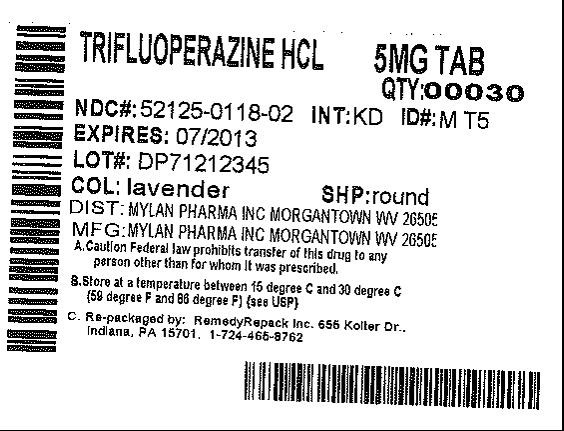Trifluoperazine Hydrochloride
FULL PRESCRIBING INFORMATION: CONTENTS*
- WARNING
- TRIFLUOPERAZINE HYDROCHLORIDE DESCRIPTION
- INDICATIONS & USAGE
- TRIFLUOPERAZINE HYDROCHLORIDE CONTRAINDICATIONS
- WARNINGS
- PRECAUTIONS
- TRIFLUOPERAZINE HYDROCHLORIDE ADVERSE REACTIONS
- OVERDOSAGE
- DOSAGE & ADMINISTRATION
- HOW SUPPLIED
- STORAGE AND HANDLING
- PACKAGE LABEL.PRINCIPAL DISPLAY PANEL SECTION
FULL PRESCRIBING INFORMATION
WARNING
Increased Mortality in Elderly Patients with Dementia-Related PsychosisElderly patients with dementia-related psychosis treated with antipsychotic drugs are at an increased risk of death. Analyses of seventeen placebo-controlled trials (modal duration of 10 weeks), largely in patients taking atypical antipsychotic drugs, revealed a risk of death in drug-treated patients of between 1.6 to 1.7 times the risk of death in placebo-treated patients. Over the course of a typical 10-week controlled trial, the rate of death in drug-treated patients was about 4.5%, compared to a rate of about 2.6% in the placebo group. Although the causes of death were varied, most of the deaths appeared to be either cardiovascular (e.g., heart failure, sudden death) or infectious (e.g., pneumonia) in nature. Observational studies suggest that, similar to atypical antipsychotic drugs, treatment with conventional antipsychotic drugs may increase mortality. The extent to which the findings of increased mortality in observational studies may be attributed to the antipsychotic drug as opposed to some characteristic(s) of the patients is not clear. Trifluoperazine hydrochloride is not approved for the treatment of patients with dementia-related psychosis (see WARNINGS).
TRIFLUOPERAZINE HYDROCHLORIDE DESCRIPTION

C21H24F3N3SM.W. 480.43
INDICATIONS & USAGE
WARNINGS).
TRIFLUOPERAZINE HYDROCHLORIDE CONTRAINDICATIONS
WARNINGS
Increased Mortality in Elderly Patients with Dementia-Related PsychosisElderly patients with dementia-related psychosis treated with antipsychotic drugs are at an increased risk of death. Trifluoperazine hydrochloride is not approved for the treatment of patients with dementia-related psychosis (see BOXED WARNING).
Tardive Dyskinesia
PRECAUTIONSandADVERSE REACTIONS.
Neuroleptic Malignant Syndrome (NMS)
Usage in Pregnancy
Pregnancy
Nursing Mothers
PRECAUTIONS
GeneralLong-Term Therapy
Leukopenia, Neutropenia and Agranulocytosis
TRIFLUOPERAZINE HYDROCHLORIDE ADVERSE REACTIONS
Neuromuscular (Extrapyramidal) Reactions
Motor Restlessness
Dystonia
Pseudoparkinsonism
Symptoms may include: mask-like facies; drooling; tremors; pill-rolling motion; cogwheel rigidity; and shuffling gait. Reassurance and sedation are important. In most cases these symptoms are readily controlled when an antiparkingsonism agent is administered concomitantly. Antiparkinsonism agents should be used only when required. Generally, therapy of a few weeks to 2 or 3 months will suffice. After this time, patients should be evaluated to determine their need for continued treatment. (Note: Levodopa has not been found effective in pseudoparkinsonism.) Occasionally it is necessary to lower the dosage of trifluoperazine hydrochloride or to discontinue the drug.
Tardive Dyskinesia
Adverse Reactions Reported with Trifluoperazine Hydrochloride or Other Phenothiazine Derivatives
WARNINGS.)
OVERDOSAGE
ADVERSE REACTIONS.)Symptoms
Treatment
Do not attempt to induce emesis because a dystonic reaction of the head or neck may develop that could result in aspiration of vomitus.Extrapyramidal symptoms may be treated with antiparkinsonism drugs, barbiturates, or diphenhydramine hydrochloride. See prescribing information for these products. Care should be taken to avoid increasing respiratory depression. If administration of a stimulant is desirable, amphetamine, dextroamphetamine, or caffeine with sodium benzoate is recommended. Stimulants that may cause convulsions (e.g., picrotoxin or pentylenetetrazol) should be avoided.
DOSAGE & ADMINISTRATION
ADULTSElderly Patients
Non-Psychotic Anxiety
Schizophrenia
DOSAGE AND ADMINISTRATION-SCHIZOPHRENIA IN CHILDREN
Oral
HOW SUPPLIED
T3 on one side of the tablet andM on the other side. They are available as follows:
T4 on one side of the tablet andM on the other side. They are available as follows:
T5 on one side of the tablet andM on the other side. They are available as follows:
T6 on one side of the tablet andM on the other side. They are available as follows:
STORAGE AND HANDLING
Store at 20 to 25 C(68 to 77 F). [See USP Controlled Room Temperature.]PACKAGE LABEL.PRINCIPAL DISPLAY PANEL SECTION


Trifluoperazine HydrochlorideTRIFLUOPERAZINE HYDROCHLORIDE TABLET, FILM COATED
| |||||||||||||||||||||||||||||||||||||||||||||||||||||||||||||
PLEASE, BE CAREFUL!
Be sure to consult your doctor before taking any medication!